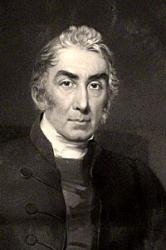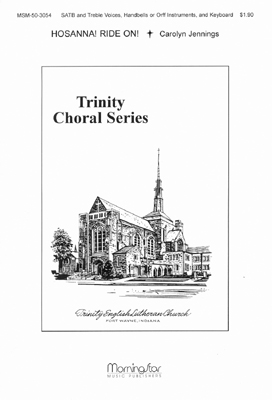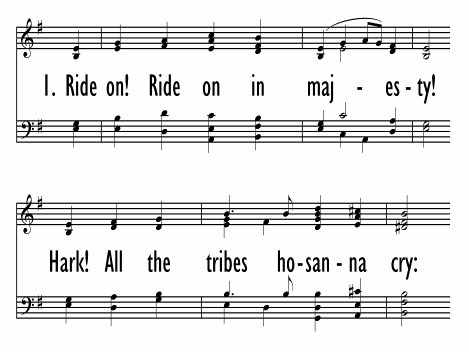- |
User Links
Ride on! ride on in majesty!

Ride on! ride on in majesty!
Author: Henry Hart Milman (1827)Published in 510 hymnals
Printable scores: PDF, MusicXMLPlayable presentation: Lyrics only, lyrics + musicAudio files: MIDI, Recording
Representative Text
1 Ride on, ride on in majesty!
Hear all the tribes hosanna cry;
O Savior meek, pursue Your road
with palms and scattered garments strowed.
2 Ride on, ride on in majesty!
In lowly pomp ride on to die.
O Christ, Your triumphs now begin
o’er captive death and conquered sin.
3 Ride on, ride on in majesty!
The host of angels in the sky
look down with sad and wond'ring eyes
to see th'approaching Sacrifice.
4 Ride on, ride on in majesty!
Your last and fiercest strife is nigh.
The Father on His sapphire throne
awaits His own anointed Son.
5 Ride on, ride on in majesty!
In lowly pomp ride on to die,
bow Your meek head to mortal pain,
then take, O Christ, Your pow'r and reign.
Source: Psalms and Hymns to the Living God #259
Author: Henry Hart Milman
 Milman, Henry Hart, D.D., the youngest son of Sir Francis Milman (who received his Baronetage as an eminent Court physician), was born Feb. 10th, 1791, and educated at Dr. Burney's at Greenwich, and subsequently at Eton. His career at B. N. C. Oxford, was brilliant. He took a first class in classics, and carried off the Newdigate, Latin Verse, Latin Essay, and English Essay. His Newdigate on the Apollo Belvedere, 1812, is styled by Dean Stanley "the most perfect of Oxford prize poems." His literary career for several years promised to be poetical. His tragedy Fazio was played at Covent Garden, Miss O'Neill acting Bianca. Samor was written in the year of his appointment to St. Mary's, Reading (1817); The Fall of Jerusalem (1820); Belshazzar… Go to person page >
Milman, Henry Hart, D.D., the youngest son of Sir Francis Milman (who received his Baronetage as an eminent Court physician), was born Feb. 10th, 1791, and educated at Dr. Burney's at Greenwich, and subsequently at Eton. His career at B. N. C. Oxford, was brilliant. He took a first class in classics, and carried off the Newdigate, Latin Verse, Latin Essay, and English Essay. His Newdigate on the Apollo Belvedere, 1812, is styled by Dean Stanley "the most perfect of Oxford prize poems." His literary career for several years promised to be poetical. His tragedy Fazio was played at Covent Garden, Miss O'Neill acting Bianca. Samor was written in the year of his appointment to St. Mary's, Reading (1817); The Fall of Jerusalem (1820); Belshazzar… Go to person page >Text Information
Related Texts
| First Line: | Ride on! ride on in majesty! |
| Author: | Henry Hart Milman (1827) |
| Meter: | 8.8.8.8 |
| Language: | English |
| Copyright: | Public Domain |
- Year A, Lent, Palm Sunday
This is recommended for Year A, Lent, Palm Sunday by 5 hymnal lectionary indexes including Glory to God: the Presbyterian Hymnal #198 and Lift Up Your Hearts: psalms, hymns, and spiritual songs #149. - Year A, Lent, Palm Sunday
Processional (NPM) - Year A, Ordinary Time, Proper 9 (14)
This is recommended for Year A, Ordinary Time, Proper 9 (14) by 2 hymnal lectionary indexes including Lift Up Your Hearts: psalms, hymns, and spiritual songs #149. - Year B, Lent, Palm Sunday
This is recommended for Year B, Lent, Palm Sunday by 5 hymnal lectionary indexes including Glory to God: the Presbyterian Hymnal #198 and Lift Up Your Hearts: psalms, hymns, and spiritual songs #149. - Year C, Lent, Palm Sunday
This is recommended for Year C, Lent, Palm Sunday by 5 hymnal lectionary indexes including Glory to God: the Presbyterian Hymnal #198 and Lift Up Your Hearts: psalms, hymns, and spiritual songs #149. - Year C, Lent, Palm Sunday
Processional (NPM)
Notes
Scripture References:
all st. = Matt 21:1-17
Henry H. Milman (b. St. James, London, England, 1791; d. Sunninghill, Berkshire, England, 1868) wrote this text around 1822. It was first published in Reginald Heber's (PHH 249) Hymns Written and Adapted to the Weekly Church Services of the Year (1827). Of the text of this fine Palm Sunday hymn, Stanley L. Osborne (PHH 395) has written,
Objective, robust, confident, and stirring, it possesses that peculiar combination of tragedy and victory which draws the singer into the very centre of the drama. It is this which gives the hymn its power and its challenge (If Such Holy Song, 449).
The text unites meekness and majesty, sacrifice and conquest, suffering and glory–all central to the gospel for Palm Sunday. Each stanza begins with "Ride on, ride on in majesty." Majesty is the text's theme as the writer helps us to experience the combination of victory and tragedy that characterizes the Triumphal Entry. Christ is hailed with "Hosanna" as he rides forth to be crucified (st. 1). That death spells victory: it is his triumph "o'er captive death and conquered sin" (st. 2). God the Father awaits Christ's victory with expectation (st. 3). Finally, Christ rides forth to take his "power … and reign!" (Note how "reign" is subtly offered as both noun and verb.) The original third stanza was not included.
Milman was a playwright, professor of poetry, historian, theologian, churchman, and hymn writer–and he was successful in all these areas. He graduated from Brasenose College, Oxford, England, in 1816, and by 1823 had written three popular plays with religious themes. He was appointed professor of poetry at Oxford in 1821 but turned to the study of church history after 1827. His History of the Jews (1829), which raised vehement protest from reviewers, was influenced by the new critical German methods. Ordained in 1817, Milman served St. Mary's Church in Reading and St. Margaret's Church in London; his most illustrious church appointment was as dean of St. Paul's Cathedral, London, a position he held from 1849 until his death. His finest scholarly work is his History of Latin Christianity (1854). Milman wrote thirteen hymns, all published in Bishop Heber's Hymns (1827).
Liturgical Use:
Obligatory for every Palm Sunday morning worship service (with 375/376).
--Psalter Hymnal Handbook
==========================
Ride on, ride on in majesty . H. H. Milman. [Palm Sunday .] Published in Bishop Heber's posthumous Hymns, &c, 1827, p. 58, in 5 stanzas of 4 lines, and again in Milman's Selection of Psalms & Hymns, 1837, No. i., for Palm Sunday. The opening stanza, which reads:—
"Ride on! ride on in majesty!
Hark! all the tribes Hosannacry!
Thine humble beast pursues his road,
With palms and scatter'd garments strew'd,"
has failed to be acceptable to most editors. Murray, in his Hymnal, 1852, endeavoured to soften down the third line by making it read:—
"0 Saviour meek, pursue Thy road." This was adopted by Hymns Ancient & Modern., and others. In 1855 Mercer tried another change:—
“With joyous throngs pursue Thy road,"
but this has received but little attention. Several hymnals follow the example of Elliott's Psalms & Hymn, 1835, and omit st. i. These include the Society for Promoting Christian Knowledge Church Hymns, 1871. Original text in Book of Praise, 1862-67. This hymn ranks with the best of the author's lyrics, and is the most popular hymn for Palm Sunday in the English language.
--John Julian, Dictionary of Hymnology (1907)
Tune
ST. DROSTANE (Dykes)WINCHESTER NEW
The original version of WINCHESTER NEW appeared in Musikalisches Handbuch der geistlichen Melodien, published in Hamburg, Germany, in 1690 by Georg Wittwe. It was set to the text “Wer nur den lieben Gott” (see 446). An expanded version of the tune was a setting for "Dir, dir Jehova" (see 203) in…
Timeline
Arrangements
Media
- Audio recording from Chalice Hymnal #191
- Audio recording from Church Hymnary (4th ed.) #365
- MIDI file from The Cyber Hymnal #5798
- Audio recording from Glory to God: the Presbyterian Hymnal #198
- Audio recording from Lift Up Your Hearts: psalms, hymns, and spiritual songs #149
- Audio recording from Lift Up Your Hearts: psalms, hymns, and spiritual songs #149
- Audio recording from Moravian Book of Worship #343
- MIDI file from Northfield Hymnal: for use in evangelistic and church services, conventions, sunday schools, and all prayer and social meetings of the church and home #56
- MIDI file from Psalter Hymnal (Gray) #382
- Audio recording from Rejoice in the Lord #281
- MIDI file from The Sunday School Hymnal: with offices of devotion #70a
- Audio recording from Trinity Hymnal (Rev. ed.) #237
- Audio recording from The Worshiping Church #205
- MIDI file from The Voice of Thanksgiving #26
- MIDI file from Worship and Rejoice #268


 My Starred Hymns
My Starred Hymns






